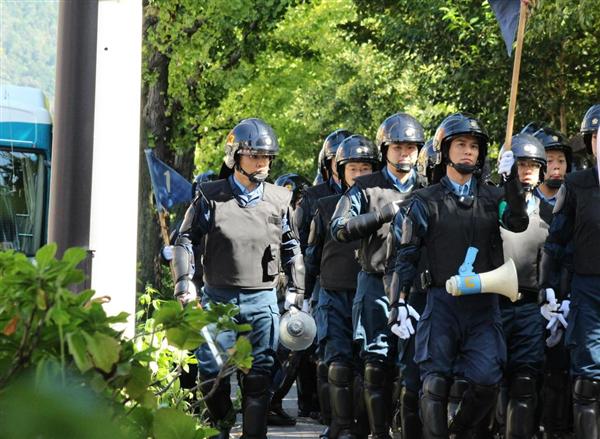On May 7th the security police were, as always, watching Zenshinsha, the headquarters of the far-left political group commonly known as Chūkaku-ha. At around 3pm a man appeared on the fifth floor roof and attempted to climb down using the drain. He slipped and fell, briefly losing consciousness.
This unnamed man has been reported as a former Chūkaku-ha activist in his twenties, allegedly confined in a room in Zenshinsha for five days from May 3rd to May 7th. He was injured in an “escape attempt”.
Hitoshi Furukōri (32) from Fukushima City and and Akinobu Ishida (28) from Sendai City have now been arrested on suspicion of causing injury by confinement. Two others have reportedly been arrested. The arrests took place on September 28th and September 30th in Tokyo and Sendai.
The Chūkaku-ha organ, Zenshin, actually openly reported this in May in issue 2681. In a long article it denounced three former senior activists as “spies”. Yasutaka Mizutani, Kōchi Kishi, and Shinzaburō Iwamoto were thrown out during the so-called Party Revolution (2006-08). Mizutani and Kishi have since written a lengthy book, published in the spring as counter-propaganda to Chukaku-ha’s own recently released official two-volume history of the 50 years since it was first founded as a splinter group in 1963.
In the same article in Zenshin it was also revealed that H, a “Fukushima University spy”, had been “exposed and crushed”. This is a quite typical presentation, whereby two seemingly unrelated elements are linked together for ideological contexts.
Though many of the details were hidden in ambiguously aggrandised language, it said that H had been in contact with a police officer who claimed to be a Fukushima University alumnus since 2012. H had apparently provided the officer with information on an independent clinic in Fukushima that was started in 2011 in part by Chūkaku-ha, offering testing for cancer caused by the radiation crisis, as well as other developments in its labour and student activism.

Police raid on Kumano Dormitory at Kyoto University.
Photo: Sankei
With the police’s active encouragement, what happened in May is being touted by the media as sōkatsu.
This is a word with chilling implications, since it recalls the Rengō Sekigun (United Red Army) purge in 1971-72. When the members of the newly united Sekigun-ha and Kakumei Saha met together in the mountains that winter, they carried out a process of internal discussion and criticism that they called sōkatsu, though this was a skewered concept of the usual process. It ended with a dozen of the members dead. As such, the word has unfortunately since come to mean far-left purges and internal conflict, with its original, non-violent sense being lost.
In fact, the case that this “Chūkaku-ha confinement” perhaps better recalls is a little earlier and less well known. When Sekigun-ha originally broke away from Bund in 1969, its leaders were confined at a university for several days that July. Eventually they were able to escape when their guards grew slack, though one, Jōshi Mochizuki, fell from the window while they made their getaway. He later died from his head injury.
Although it has shifted its focus to unionism and student activism, the police have continued to frame Chūkaku-ha still as a dangerous extremist group. While the truth in this particular case remains unclear (was there actual violence involved?), it is certain that it will be used in the mainstream media to discredit the group and spread fear about its activities.
Some of the people arrested at the Diet during protests against the security bills in September were also reportedly linked to far-left Marxist groups like Chūkaku-ha and Kakurōkyō, leading to a series of follow-up raids.
Update (October 2nd): Police Raids on Campuses
Following the arrests on September 28th and September 30th, police searched sites at Hiroshima University and Tōhoku University on October 1st, and a dormitory at Kyoto University on October 2nd (the same dormitory that was raided in late 2014). In total, seven sites nationwide were searched between September 28th and October 2nd, including Zenshinsha.
It is not yet clear why the police waited so long or how/when exactly they made the arrests. Typically security police monitor events and rallies to see if people they want turn up, and then make their move. It is also standard practice to arrest people on relatively minor charges in the hope they crack under interrogation, since police can hold suspects without charge for weeks in isolation.
The raids also point to the way that Chūkaku-ha, though frequently discarded today as a spent force in student activism, in fact still has networks at certain colleges around Japan. Following a revival centring on a protracted conflict at Hōsei University (c.2006-ongoing), Zengakuren (which exists today primarily as Chūkaku-ha’s affiliated student wing) has seen its strength slowly return. While nothing like as hyped or speedy as the growth of a group like SEALDs, the response of the police seems to indicate how Zengakuren is nonetheless viewed as a threat.
However, whatever the truth in this case (the injuries to the victim, at any rate, seemed to have been caused not by the “confinement” but by falling off the roof while trying to make his getaway), the heavy publicity it has generated may damage the reputation of Zengakuren on campuses. The opposite is also possible, of course: there’s nothing like seeing squads of riot cops storming your dormitory to inspire anger against the state.
Update (October 26th): Student Activists Released
All four Zengakuren student activists were released from police custody without charge between October 19th and October 20th.

